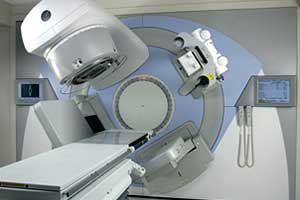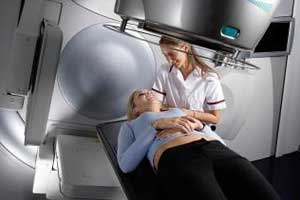Designed for Stereotactic Radiosurgery and Stereotactic Radiation Therapy
The innovative Elekta Synergy® S solution combines sophisticated integrated imaging with remarkably high-resolution radiation delivery. Elekta Synergy S sets new standards of accuracy and therapeutic efficacy in extracranial stereotactic radiation therapy (SRT) and stereotactic radiosurgery (SRS) applications. Modeled on the proven design of Elekta Synergy®, Elekta Synergy S is an image-guided robotic linear accelerator that combines high-conformance beam shaping with our exclusive 4D Adaptive™ image-guided radiation therapy (IGRT) technology for advanced stereotactic radiation treatments. It also offers all the advantages of the complete line of Elekta digital linear accelerators, including exceptional positional accuracy, integrated digital controls, open connectivity, quiet operation, and a durable, ergonomic design. Elekta Synergy S provides planar, fluoroscopic quality, and 3D X-ray volume imaging (XVI) of the patient in the treatment position.
This helps to minimize the risk of set-up error by identifying critical structures during treatment, allowing clinicians to characterize and compensate for motion. With these capabilities, Elekta Synergy S delivers a powerful combination of software-driven, 2D and 3D image-guided accuracy and highly conformal beam-shaping – two critical requirements for maximizing precision and improving patient outcomes with stereotactic treatment. Essentially, Elekta Synergy S enables clinicians to apply SRS and SRT effectively for small-field lesions and other indications with tight tumor margins.
"Princeton Neurological Surgery is truly unbelievable!! The office staff is tremendous - they are always available and return calls promptly. Cathy the office manager goes out of her way to assist you. Getting an appointment is super easy and you are seen promptly. Dr. Lipani takes his time and listens - never rushed! The office staff will follow up and stay in touch with you even after appointments or procedures. We drive almost an hour from Edison to the office simply because of Dr. Lipani and his team. I recommend Princeton Neurological Surgery to anyone who is starting the process of finding a doctor or someone who is not happy or needs a second opinion."


What is stereotactic radiosurgery?
Stereotactic radiosurgery isn’t surgery in the sense of using scalpels and making incisions. Instead, this surgery uses many precisely focused radiation beams to treat tumors and other problems in the brain, neck, lungs, liver, spine, and other parts of the body. Dr. Lipani uses 3D imaging to target high doses of radiation to the affected area with minimal impact on the surrounding healthy tissue.
What is stereotactic radiation therapy?
This term applies when stereotactic radiosurgery is used to treat tumors in areas of the body other than the brain. For these treatments, the term is stereotactic radiation therapy or stereotactic ablative radiotherapy.
How does the Elekta Synergy treat tumors and other abnormalities?
The Elekta Synergy S system focuses many small beams of radiation on a tumor or other target. Each beam has very little effect on the tissue it passes through. But the spot where all the beams intersect delivers a targeted dose of radiation. This high dose of radiation causes tumors to shrink and blood vessels to close off over time following treatment, denying the tumor its blood supply.
The accuracy of the Elekta Synergy ensures there is minimal damage to healthy surrounding tissues.
Who is a candidate for Elekta Synergy treatment?
When originally pioneered over 50 years ago, stereotactic radiosurgery was used for brain surgery. Since that time, innovations in systems such as the Elekta Synergy allow Dr. Lipani to treat a variety of patient conditions. They include:
- Brain tumors — The Elekta Synergy is used to treat brain tumors, including meningioma, paraganglioma, hemangioblastoma, and craniopharyngioma. It can also treat cancers that have spread to the brain from other areas.
- Arteriovenous malformation (AVM) — AVMs are abnormal tangles of arteries and veins in the brain. When a person has an AVM, their blood flows directly from the arteries to the veins, bypassing smaller blood vessels known as capillaries. This may disrupt the normal flow of blood, leading to hemorrhage or stroke. The Elekta Synergy destroys AVMs.
- Acoustic neuroma — These are noncancerous tumors that develop along with the main balance and hearing nerve leading from the inner ear to the brain. As the tumor places pressure on the nerve, a person can experience hearing loss, dizziness, loss of balance, and ringing in the ear. Further growth can affect facial muscles.
- Pituitary tumors — Elekta shrinks tumors that have formed on the pituitary gland at the base of the brain. These tumors can disrupt the normal function of the pituitary, which controls hormones that manage many functions in the body, from metabolism to sexual function.
- Tremors — The Elekta Synergy provides stereotactic radiosurgery to treat tremors associated with functional neurological disorders such as Parkinson’s disease and essential tremor.
- Other cancers — The Elekta can treat cancers of the liver, lung, and spine.
What happens during an Elekta treatment?
These treatments involve four phases: head frame placement, imaging, computerized dose planning, and radiation delivery.
- Headframe placement — A lightweight frame is attached to your head with four pins. This will stabilize your head during the radiation treatment and serve as a point of reference for focusing the beams of radiation.
- Imaging — Once the head frame is attached, you’ll undergo imaging scans of your brain that show the location of the tumor or other abnormality in relation to the head frame. The type of imaging depends upon the condition being treated.
- Dose planning — The results of the brain scans are fed into a computerized planning system that enables Dr. Lipani to plan the appropriate areas to treat, dosages of radiation, and how to focus the radiation beams to treat the areas.
- Radiation delivery — The Elekta Synergy machine moves and rotates around the target during treatment to deliver radiation beams from different angles. You don’t feel the radiation at all, and you are able to talk with Dr. Lipani via a microphone. This phase takes less than an hour.
What are the benefits of the Elekta Synergy stereotactic radiosurgery?
The benefits delivered by this system enable Dr. Lipani to have ultimate precision when treating all of the above conditions. Delivery of the radiation is accurate to within one to two millimeters. Because of this accuracy, stereotactic radiosurgery can deliver precisely targeted radiation at much higher doses. This requires only a single treatment or just a few treatments, improving upon traditional radiation therapy.
Our Elekta Synergy enables Dr. Lipani to provide alternatives to invasive surgery. This is critical for patients who are unable to undergo surgery and for tumors and abnormalities that are hard to reach, located close to vital organs/anatomic regions or subject to movement within the body.
How long does an Elekta Synergy treatment take?
These procedures with Dr. Lipani may take less than an hour to about four hours, depending on the size and shape of the target. These are outpatient procedures, but the entire process from start to finish will take most of the day.
What are the risks involved with stereotactic radiosurgery?
Because these procedures don’t involve surgical incisions, they are less risky than traditional surgery to treat these tumors or other abnormalities. Early complications or side effects with stereotactic radiosurgery or stereotactic radiation therapy are usually temporary. They may include:
- Fatigue — You may feel fatigued for the first few weeks after your treatment.
- Swelling — Swelling in the brain at or near the treatment site can cause signs and symptoms such as headaches, nausea, and vomiting. Dr. Lipani may prescribe anti-inflammatory medication to prevent these symptoms.
- Scalp and hair problems — Your scalp may be red, irritated, or sensitive at sites where the head frame was attached. Some patients lose a small amount of hair, but this is temporary.
Schedule Your Consultation Today
If you’re interested in learning more about Elekta Synergy® S please contact us for a consultation at (609) 890-3400 or fill out our contact us form. We will discuss your needs and concerns, and determine your best course of action.

